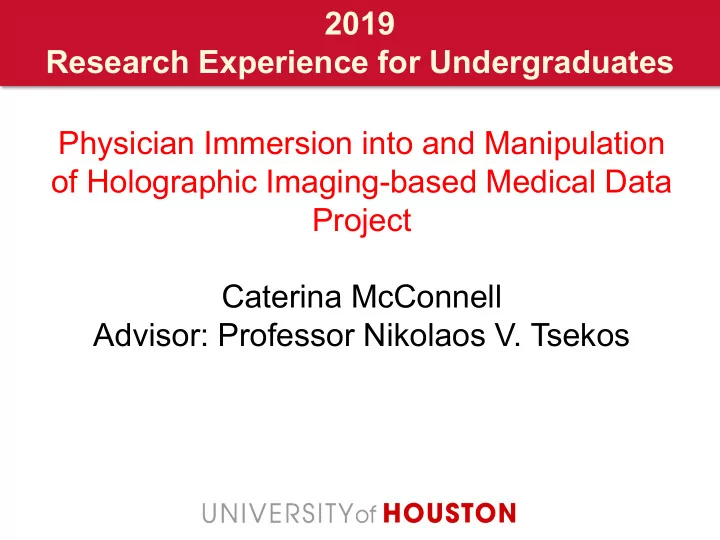

2019 Research Experience for Undergraduates Physician Immersion into and Manipulation of Holographic Imaging-based Medical Data Project Caterina McConnell Advisor: Professor Nikolaos V. Tsekos
Motivation Minimally invasive surgery has become a growing technique in the medical field. With the visualization on the surgical plane hindered, surgeons must rely on prior scans to view the area of interest.
Goal Perform ultrasounds of 10 different mice. Segment the left ventricle of each mouse heart. Use this segmentation data to construct the holographic heart model.
Objectives Collect the following data: • Cardiac Data (Morphology and Function) • Doppler Imaging (Vascular Flow) Utilize VevoLab software to segment the Left Ventricle of the mouse heart in B-Mode.
Expected Impact Physicians will be able to utilize this research in ultrasound data segmentation I order to capture images in real-time for image guided surgery.
Deliverables Clean Data: • B-Mode Images • M-Mode Images • 3D-Mode Video • PW Tissue Doppler Images Segmented Data: • Dicom B-Mode Image Frames
Test Subject Information • Five Female Wild-Type (WT) Mice • Five Male Wild-Type (WT) Mice • Age: ~6 Weeks (Born 4/27/2019) • Strain: C57bl/6J • Test Date: 6/7/2019
Methods: Objective 1 B-Mode • Brightness Mode • Displays a 2D image of the body
Results: Objective 1 Data was segmented using AutoLV first to test locate region. This feature was deemed inaccurate and the points were then drawn and adjusted manually to trace around the left ventricle as shown. Short Axis Long Axis
Methods: Objective 2 M-Mode • Motion Mode • B- Mode image is taken as each pulse is emitted. • Images are placed in sequence to form a video. • Measures velocity
Results: Objective 2
Methods: Objective 3 3D-Mode • Uses volume rendering to form image • Performed mechanically: Probe motor uses tilt feature to capture image slices in a series of different orientations.
Results: Objective 3
Methods: Objective 4 PW Tissue Doppler • Pulsed Wave Tissue Doppler • Uses the Doppler Effect: Changes in pitch due to the increase or decrease of sound and light waves as the wave source moves closer or farther from the observer. • Measures blood flow from a sample volume • Forms a 2D image • Blood flow measured on a timeline
Results: Objective 4
Results Comparative Images MRI Image Ultrasound Image
Remaining Work • Work with a ultrasound “expert” to validate data. • Use AutoLV feature and manual segmentation to research other segmentation techniques to heighten maximum segmentation frames allowed. • Induce congestive heart failure in the mice and perform LV segmentation to obtain a diverse range of data.
Conclusions After performing each ultrasound test, B-Mode images were deemed the best for segmentation. The VevoLab software is effective in segmentation, yet the automatic segmentation program (AutoLV) is not consistently accurate. Further research could be conducted with diseased hearts. In this research, the B-Mode manual segmentation would be used while understanding that the anatomy would change as heart defects progress. These conclusions would aide physicians in the transition to using real-time image techniques during operation.
Acknowledgements The REU project is sponsored by NSF under award NSF-1659755. Special thanks to the following UH offices for providing financial support to the project: Department of Computer Science; College of Natural Sciences and Mathematics; Dean of Graduate and Professional Studies; VP for Research; and the Provost's Office. The views and conclusions contained in this presentation are those of the author and should not be interpreted as necessarily representing the official policies, either expressed or implied, of the sponsors.
Recommend
More recommend